Kristine Hughes's Blog, page 119
October 24, 2012
Gillpin and the Picturesque
Victoria here. Today, I want to explore -- or at least skim over -- the concept of the Picturesque -- as a sort of introduction to bringing a few scenes from The Tour of Dr. Syntax to this blog.
I am sure that like me, you have your own personal idea of what "picturesque" means. My ideas were formed before learning of the particular theories of Rev. William Gilpin in the 18th Century. Before consulting the dictionary, I found this picture of a quaint cottage which I would call picturesque. In fact, in my mind, I guess picturesque is almost a synonym for quaint. Or pretty, charming, old fashioned, etc.
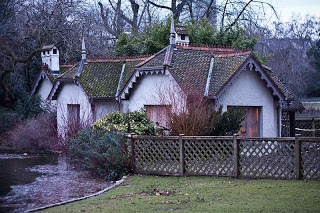 Duck Island Cottage, St. James Park, London
Duck Island Cottage, St. James Park, LondonBut this is not what Gilpin and meant by "Picturesque." His theory was more sweeping (pretentious???).
Many 18th century theorists wrote on aesthetics. They differentiated among definitions of "beauty" (instinctively attractive and pleasing) and "sublime" (inspiring awe, perhaps even fear or terror). They argued among themselves about nuances of various meanings.
With the benefit of hindsight, we can identify signposts on Western culture's journey from the Age of Enlightenment to the Age of Romanticism, from the emphasis on classical ideals to nature's sometime-chaos. This aesthetic debate was part of it, from the balanced proportions of classicism to the wild torrents of the romantic in art.
Here are two examples of what I mean, not necessarily what ANYONE else means.
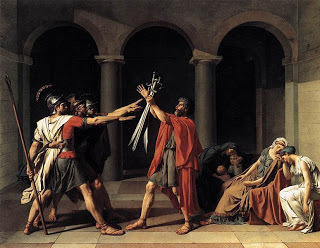 Jacques-Louis David, Oath of the Horatii, 1784 The Louvre, ParisExample of (neo)classicism
Jacques-Louis David, Oath of the Horatii, 1784 The Louvre, ParisExample of (neo)classicism J.M.W. Turner, Tintern Abbey, 1794, Tate BritainExample of Romanticism
J.M.W. Turner, Tintern Abbey, 1794, Tate BritainExample of RomanticismThe extremes of the two styles are perhaps even more evident in architecture.
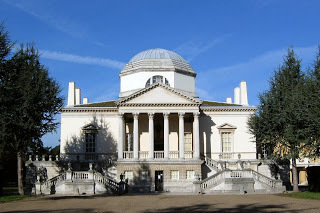 Chiswick House, Greater London, English Heritage, finished 1729Lord Burlington and William Kent, architects in the Palladian neoclassical style
Chiswick House, Greater London, English Heritage, finished 1729Lord Burlington and William Kent, architects in the Palladian neoclassical style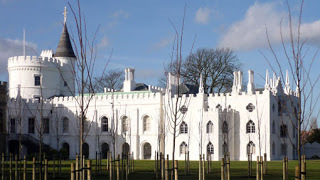 Strawberry Hill House, Great London, redone from 1749-1776Horace Walpole and friends, architects, in the neo-Gothic style
Strawberry Hill House, Great London, redone from 1749-1776Horace Walpole and friends, architects, in the neo-Gothic styleOn that great aesthetic journey from the Age of Classicism/Reason to Romanticism, one of the movers and shakers was William Gilpin, who lived from 1724 to 1804. Gilpin was a clergyman, travel writer and observer who developed ideas about what was worthy of a picture -- that is, by his definition, picturesque -- in the English countryside.
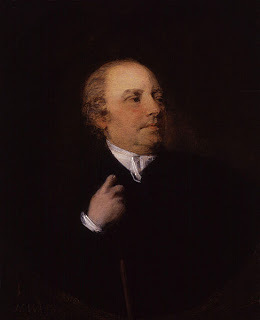 William Gilpin by artist Henry Walton, 1791, NPG, London
William Gilpin by artist Henry Walton, 1791, NPG, LondonAt Queen's College, Oxford, before being ordained as an Anglican clergyman, Gilpin wrote of landscape and what he believed made a scene picturesque, that is worthy of sketching or painting. He liked wild scenes, craggy mountains, twisted trees, a general sense of unquiet in nature. In the last quarter of the 18th century, his travel writings and the engravings of his nephew became widely read and studied. These trips were taken in the intervals between his terms as headmaster of a school for boys.
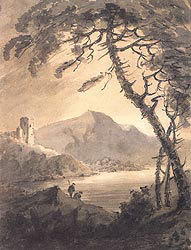 William Gilpin, Landscape with a Ruined Castle, 1790, watercolor.
William Gilpin, Landscape with a Ruined Castle, 1790, watercolor.Gilpin's work was very influential among aesthetic theoreticians and artists. Perhaps one of his most famous "pupils" was the landscape designer Humpry Repton, who often "improved" on Capability Brown's classical English landscape to include a grotto or a hermitage, for example.
Gilpin's writings and drawings were well known to Jane Austen, who referred to his views in several of her novels, sometimes in a rather satirical vein. For an excellent discussion of JA and WG, see the excellent blog AustenOnly here.
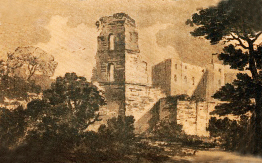 William Gilpin, Scaleby Castle, Cumbria
William Gilpin, Scaleby Castle, CumbriaAll of this discussion is by way of introduction to a few posts I will be doing here in the next weeks, dealing with The Tour of Dr. Syntax in search of the Picturesque by William Combe (1741-1823), another writer who took a satirical view of Gilpin and other travel writers of his time.
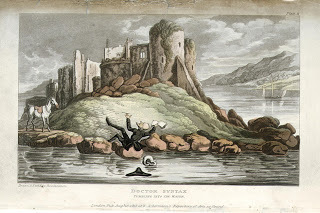
The contrast in approach can be easily seen in the two pictures above (perhaps enlarged for clearer viewing), with Dr. Syntax falling backward into the river in front of the castle, in one of the many illustrations for the series done by artist Thomas Rowlandson.
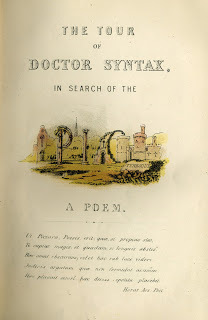
I hope you enjoy the excerpts I choose from Combe's lines and the wonderful illustrations by Rowlandson, to start soon.
Published on October 24, 2012 01:00
October 22, 2012
A Couple In England - In Search of a Happy Medium
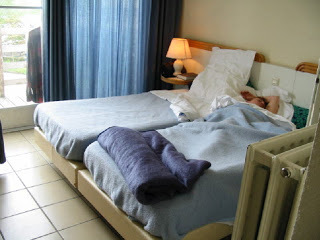
As you can imagine, with less than two months to go until our sojourn to England, I have been meticulously planning each and every day of our vist to London, Bath and Winsdor. Okay, I've been micro-planning every day. Which isn't easy, as there's so much to do and so little time, not to mention the fact that I've got to devise an itinerary that will strike just the right balance between keeping Hubby entertained and simply exhausting him. As it is, he's dreading being with me in London again, when I go into "London mode." That is, with so little time at my disposal, I get up at dawn, walk at warp speed, go all day long and fall glassy eyed into bed each night.
Recently, I let Hubby in on what I've planned for us in London - so far: Kensington Palace, the Vault at the Hard Rock Cafe (for rock loving Hubby), the Changing of the Guard, the Guards Museum, Fortnum and Mason, Liberty's, Winter Wonderland in Hyde Park (including tickets to the circus and observation wheel), theatre tickets (One Man, Two Guvnors), a three hour chauffeured Beatles and rock tour of London (for Hubby), Apsley House, a visit to my favourite antique dealer, a bit of shopping, dinner at the Duke of Wellington pub, a stop at Boots in order stock up on make-up and toiletries, a bookstore or two, etc. etc. etc. I finished telling him about our itinerary with the question, "Do you want to go to the Hollywood movie costume exhibit at the Victoria and Albert Museum?" To which he responded, a tad touchily (IMHO)"Do you?"
"You know," he continued, "we don't have to do something every single minute of every single day." I think I mentioned in a previous post what a comedian the man can be. "Aren't we going to have any time to just relax in the hotel room?"
"You want me to go to London and spend time in the room?"
"Do you have something planned for us every night, too?
"Well . . . yes, but some nights will be earlier than others."
""They may be earlier than you think. Especially for me. I need my rest. I'm old."
"You're not that old. Not old enough to go to London and spend all your time in the hotel room." I would have quoted Dr. Johnson's famous "tired of London, tired of Life" line to him if I'd thought it would do any good, but managed to refrain.
Honestly, he should only know what I've left off the agenda - a moonlit stroll along the Embankment, ice skating at Somerset House, research at the British Library, an hour or so smelling candles at Jo Malone, Portobello Road, Maggs Brothers, etc. etc. etc. The sacrifices I make . . . . I can hardly wait until I break the news to him about our Bath itinerary. Hopefully Hubby won't notice that I've only scheduled seven hours between our ringing in the New Year and visiting Longleat House. Sleeping is so overrated . . . . .
[image error]
Published on October 22, 2012 11:39
October 15, 2012
Treasures of Kenwood Exhibition Opens in Milwaukee
Victoria here. I have been eagerly awaiting this exhibition of great paintings from London's Kenwood House. While the great mansion near Hampstead Heath is being refurbished, a selection of the finest paintings from the Iveagh Bequest, usually on display there, are traveling around the U.S. First stop was Houston, and now it is in my front yard until January 13, 2013. Hurrah!!
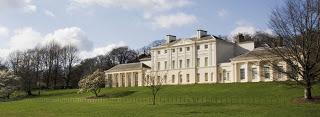 Kenwood House, The Iveagh Bequest, 18th C.
Kenwood House, The Iveagh Bequest, 18th C.
The Milwaukee Art Museum has a home equally stunning to Kenwood, if diametrically opposed in style.
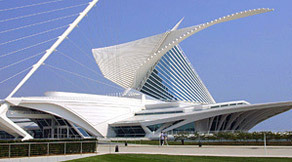 Milwaukee Art Museum, 21st C.
Milwaukee Art Museum, 21st C.
The MAM mounted the paintings in a stunning series of rooms, the walls colored to enhance enjoyment of the works, from delicate blues to vivid crimson. Accompanied by excellent text panels, brochures, audio guides, and catalogues, the exhibition will also feature lectures, gallery talks and book signings. The full schedule can be found here. I wrote about the traveling exhibition and Kenwood House on this blog in August, and you can read it here.
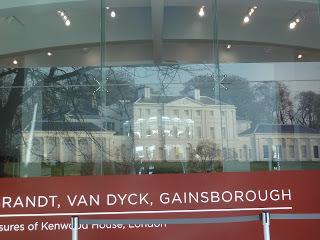
Entering the exhibition preview day, along with hundreds of other eager members, I had to put away my camera since no photos were allowed within. You will see many of the paintings below, from more official sources, until I make my very predictable way to the Gift Shop.
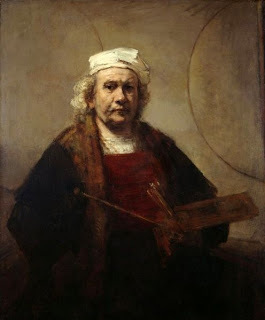 Rembrandt van Rijn, Portrait of the Artist, ca. 1665
Rembrandt van Rijn, Portrait of the Artist, ca. 1665
Undoubtedly the premier painting to most viewers is this moving self-portrait Rembrandt painted about 1665 at age 60. Other outstanding paintings from the low countries include portraits by Franz Hals, Anthony Van Dyke, and Ferdinand Bol, and landscapes by Cuyp and others
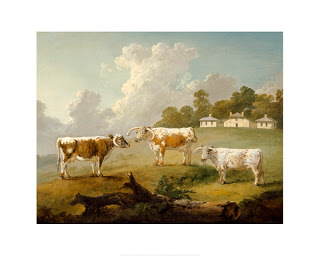 Julius Caesar Ibbetson, Three Long-Horned Cattle at Kenwood, 1797English Heritage Purchase, 1999
Julius Caesar Ibbetson, Three Long-Horned Cattle at Kenwood, 1797English Heritage Purchase, 1999
The painting above was acquired for the collection fairly recently because it shows the Dairystanding in Kenwood's park, though the three cows are quite detailed and worthwhile in their own regard, I guess. After the current restoration at Kenwood, the Dairy will be open to visitors.
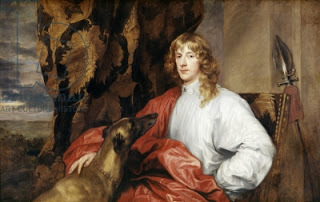 Anthony Van Dyke, James Stuart, 1st Duke of Richmond and 4th Duker of Lennox, ca.1636Iveagh Bequest
Anthony Van Dyke, James Stuart, 1st Duke of Richmond and 4th Duker of Lennox, ca.1636Iveagh Bequest
Van Dyke, who was born in Antwerp, painted many English courtiers and the royal family during the reign of Charles I. His barooque techniques of portraiture inspired many artists. You will not be surprised to know that my favorite pictures, the ones I lingered over the longest were the English portraits, by all of the leading lights of the late 18th and early 19th centuries.
Mrs. Sophia Musters (1758-1819), a popular society beauty, is painted below by Reynolds as Hebe on Mount Olympus, pouring nectar for a magnificent eagle, who represents the god Zeus. The catalogue refers to this painting as the "ultimate male fantasy."
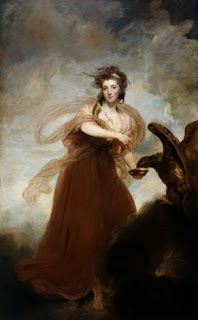
Joshua Reynolds, Mrs. Musters as "Hebe," 1782
Iveagh Bequest I remember attending an exhibition at the Tate Britain a few years ago, Joshua Reynolds: The Creation of Celebrity, in which the following portrait of Kitty Fisher, a courtesan as Cleopatra, was shown. Reynolds painted many women who were actresses and/or courtesans, adding to their celebrity.
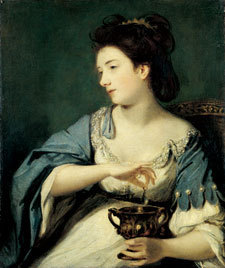 Reynolds, Kitty Fisher as "Cleopatra" Dissolving the Pearl, 1759
Reynolds, Kitty Fisher as "Cleopatra" Dissolving the Pearl, 1759
Perhaps the most famous of the actresses who were also mistresses of prominent men was Dora Jordan (1761-1849), who was very popular on the stage, particularly in comedic roles. For many years, she lived with the younger brother of the Prince Regent, the Duke of Clarence (1765-1837). Dora bore him ten children, but in the aftermath of the death of Princess Charlotte, only child of the Prince Regent, the Duke of Clarence had to marry and an actress would never do as the potential queen.
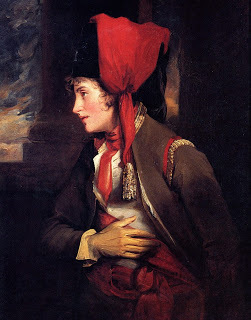 John Hoppner, Mrs. Jordan as "Viola" in "Twelfth Night," ca. 1785-92Iveagh Bequest
John Hoppner, Mrs. Jordan as "Viola" in "Twelfth Night," ca. 1785-92Iveagh Bequest
Long before he became King William IV, the Duke had abandoned Dora, who died in poverty. But King William did take care of his illegitimate offspring, making the eldest boy an earl and overseeing good marriages for the others. He and his wife, Adelaide of Saxe-Meiningen (1792-1859), had several children who died at birth or shortly thereafter. The ultimate successor was Princess Victoria, daughter of Prince Edward, Duke of Kent, an even younger brother of George and William.
I will return to the exhibition soon and share with you more of its contents. Until there, here are a few shots in the busy Gift Shop.
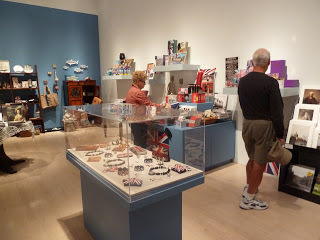
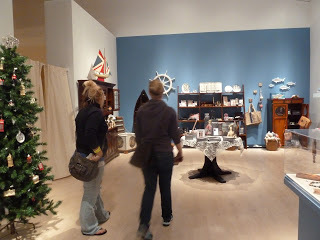 Milwaukee Art Museum Exhibition Shop
Milwaukee Art Museum Exhibition Shop
You can access the Milwaukee Art Museum Shop here.
[image error]
 Kenwood House, The Iveagh Bequest, 18th C.
Kenwood House, The Iveagh Bequest, 18th C.The Milwaukee Art Museum has a home equally stunning to Kenwood, if diametrically opposed in style.
 Milwaukee Art Museum, 21st C.
Milwaukee Art Museum, 21st C.The MAM mounted the paintings in a stunning series of rooms, the walls colored to enhance enjoyment of the works, from delicate blues to vivid crimson. Accompanied by excellent text panels, brochures, audio guides, and catalogues, the exhibition will also feature lectures, gallery talks and book signings. The full schedule can be found here. I wrote about the traveling exhibition and Kenwood House on this blog in August, and you can read it here.

Entering the exhibition preview day, along with hundreds of other eager members, I had to put away my camera since no photos were allowed within. You will see many of the paintings below, from more official sources, until I make my very predictable way to the Gift Shop.
 Rembrandt van Rijn, Portrait of the Artist, ca. 1665
Rembrandt van Rijn, Portrait of the Artist, ca. 1665Undoubtedly the premier painting to most viewers is this moving self-portrait Rembrandt painted about 1665 at age 60. Other outstanding paintings from the low countries include portraits by Franz Hals, Anthony Van Dyke, and Ferdinand Bol, and landscapes by Cuyp and others
 Julius Caesar Ibbetson, Three Long-Horned Cattle at Kenwood, 1797English Heritage Purchase, 1999
Julius Caesar Ibbetson, Three Long-Horned Cattle at Kenwood, 1797English Heritage Purchase, 1999The painting above was acquired for the collection fairly recently because it shows the Dairystanding in Kenwood's park, though the three cows are quite detailed and worthwhile in their own regard, I guess. After the current restoration at Kenwood, the Dairy will be open to visitors.
 Anthony Van Dyke, James Stuart, 1st Duke of Richmond and 4th Duker of Lennox, ca.1636Iveagh Bequest
Anthony Van Dyke, James Stuart, 1st Duke of Richmond and 4th Duker of Lennox, ca.1636Iveagh BequestVan Dyke, who was born in Antwerp, painted many English courtiers and the royal family during the reign of Charles I. His barooque techniques of portraiture inspired many artists. You will not be surprised to know that my favorite pictures, the ones I lingered over the longest were the English portraits, by all of the leading lights of the late 18th and early 19th centuries.
Mrs. Sophia Musters (1758-1819), a popular society beauty, is painted below by Reynolds as Hebe on Mount Olympus, pouring nectar for a magnificent eagle, who represents the god Zeus. The catalogue refers to this painting as the "ultimate male fantasy."

Joshua Reynolds, Mrs. Musters as "Hebe," 1782
Iveagh Bequest I remember attending an exhibition at the Tate Britain a few years ago, Joshua Reynolds: The Creation of Celebrity, in which the following portrait of Kitty Fisher, a courtesan as Cleopatra, was shown. Reynolds painted many women who were actresses and/or courtesans, adding to their celebrity.
 Reynolds, Kitty Fisher as "Cleopatra" Dissolving the Pearl, 1759
Reynolds, Kitty Fisher as "Cleopatra" Dissolving the Pearl, 1759Perhaps the most famous of the actresses who were also mistresses of prominent men was Dora Jordan (1761-1849), who was very popular on the stage, particularly in comedic roles. For many years, she lived with the younger brother of the Prince Regent, the Duke of Clarence (1765-1837). Dora bore him ten children, but in the aftermath of the death of Princess Charlotte, only child of the Prince Regent, the Duke of Clarence had to marry and an actress would never do as the potential queen.
 John Hoppner, Mrs. Jordan as "Viola" in "Twelfth Night," ca. 1785-92Iveagh Bequest
John Hoppner, Mrs. Jordan as "Viola" in "Twelfth Night," ca. 1785-92Iveagh BequestLong before he became King William IV, the Duke had abandoned Dora, who died in poverty. But King William did take care of his illegitimate offspring, making the eldest boy an earl and overseeing good marriages for the others. He and his wife, Adelaide of Saxe-Meiningen (1792-1859), had several children who died at birth or shortly thereafter. The ultimate successor was Princess Victoria, daughter of Prince Edward, Duke of Kent, an even younger brother of George and William.
I will return to the exhibition soon and share with you more of its contents. Until there, here are a few shots in the busy Gift Shop.

 Milwaukee Art Museum Exhibition Shop
Milwaukee Art Museum Exhibition ShopYou can access the Milwaukee Art Museum Shop here.
[image error]
Published on October 15, 2012 01:00
October 12, 2012
At Auction
Canterbury Auctions in Kent will be hosting a two day sale beginning Tuesday, October 23 2012 and, once again, we just couldn't resist perusing their catalog. Below are just a few of the fabulous items on offer:
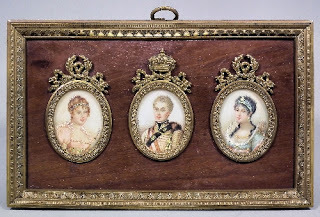
Lot 381Late 19th/early 20th Century School - Three miniature paintings on ivory - Shoulder length portraits of an aristocratic gentleman and two ladies (possibly members of the Hapsburg Royal Household), ovals 1.5ins x 1.25ins, indistinctly signed, in single gilt metal mounted mahogany rectangular three division frame, 4.75ins x 7.75ins - Guide Price: £200-300
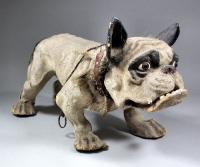 Lot 418A late 19th Century French papier-mache pull-along Bulldog with opening mouth and growling action, the head inset with glass eyes, with bristle trimmed collar for same, 21ins overall x 11.75ins high (front paws somewhat worn, various damage around chain to rear of neck, appears scuffed and marked) - Guide Price: £500-700
Lot 418A late 19th Century French papier-mache pull-along Bulldog with opening mouth and growling action, the head inset with glass eyes, with bristle trimmed collar for same, 21ins overall x 11.75ins high (front paws somewhat worn, various damage around chain to rear of neck, appears scuffed and marked) - Guide Price: £500-700
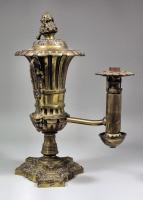
Lot 469A George IV gilt brass Colza oil lamp of two-handled urn shape with plain arm, on stepped triangular weighted base, by Smethurst of 138 New Bond Street, 15.75ins high (converted to electricity)
Guide Price: £120-160
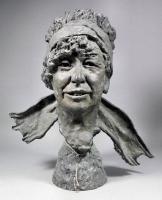 Lot 505Colin Colahan (1897-1987) - Bronze bust - "Freya Stark" (1893-1993), 19.75ins high, signed, with attached lead seal Note : Dame Freya Stark was a well known British Explorer and Travel Writer. Writing more than two dozen books about her travels in the Middle and near East, she was one of the first non-Arabs to travel through the Southern Arabian Deserts - Guide Price: £500-700
Lot 505Colin Colahan (1897-1987) - Bronze bust - "Freya Stark" (1893-1993), 19.75ins high, signed, with attached lead seal Note : Dame Freya Stark was a well known British Explorer and Travel Writer. Writing more than two dozen books about her travels in the Middle and near East, she was one of the first non-Arabs to travel through the Southern Arabian Deserts - Guide Price: £500-700
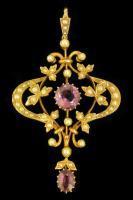
Lot 127A late Victorian 15ct gold mounted seed pearl and amethyst set pendant, the central amethyst within seed pearl set scrolling leaf pattern borders with oval amethyst suspended below, 60mm x 40mm overall (grammes 6.5 grammes), contained in original brown leather covered case retailed by Wales & McCulloch Ltd, 59 Cheapside and 20 Ludgate Hill, London) - Guide Price: £250-300


Lot 381Late 19th/early 20th Century School - Three miniature paintings on ivory - Shoulder length portraits of an aristocratic gentleman and two ladies (possibly members of the Hapsburg Royal Household), ovals 1.5ins x 1.25ins, indistinctly signed, in single gilt metal mounted mahogany rectangular three division frame, 4.75ins x 7.75ins - Guide Price: £200-300
 Lot 418A late 19th Century French papier-mache pull-along Bulldog with opening mouth and growling action, the head inset with glass eyes, with bristle trimmed collar for same, 21ins overall x 11.75ins high (front paws somewhat worn, various damage around chain to rear of neck, appears scuffed and marked) - Guide Price: £500-700
Lot 418A late 19th Century French papier-mache pull-along Bulldog with opening mouth and growling action, the head inset with glass eyes, with bristle trimmed collar for same, 21ins overall x 11.75ins high (front paws somewhat worn, various damage around chain to rear of neck, appears scuffed and marked) - Guide Price: £500-700
Lot 469A George IV gilt brass Colza oil lamp of two-handled urn shape with plain arm, on stepped triangular weighted base, by Smethurst of 138 New Bond Street, 15.75ins high (converted to electricity)
Guide Price: £120-160
 Lot 505Colin Colahan (1897-1987) - Bronze bust - "Freya Stark" (1893-1993), 19.75ins high, signed, with attached lead seal Note : Dame Freya Stark was a well known British Explorer and Travel Writer. Writing more than two dozen books about her travels in the Middle and near East, she was one of the first non-Arabs to travel through the Southern Arabian Deserts - Guide Price: £500-700
Lot 505Colin Colahan (1897-1987) - Bronze bust - "Freya Stark" (1893-1993), 19.75ins high, signed, with attached lead seal Note : Dame Freya Stark was a well known British Explorer and Travel Writer. Writing more than two dozen books about her travels in the Middle and near East, she was one of the first non-Arabs to travel through the Southern Arabian Deserts - Guide Price: £500-700
Lot 127A late Victorian 15ct gold mounted seed pearl and amethyst set pendant, the central amethyst within seed pearl set scrolling leaf pattern borders with oval amethyst suspended below, 60mm x 40mm overall (grammes 6.5 grammes), contained in original brown leather covered case retailed by Wales & McCulloch Ltd, 59 Cheapside and 20 Ludgate Hill, London) - Guide Price: £250-300
Published on October 12, 2012 23:30
October 11, 2012
Have Yourself A Tasty Little Christmas
The holidays will be upon us before we know it and what better way to get into the festive spirit than with seasonal food and drink? Mark your calendars now for the following events - I'll personally be attending the Live Tudor Cookery at Hampton Court Palace and will be sure to post about it in January.
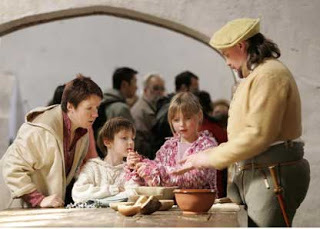 Country Living Magazine Christmas Fair 2012 in London 7th - 11th November 2012 - Business Design Centre, 52 Upper Street, Islington, London, N1 0QH Telephone: 020 7420 7738
Country Living Magazine Christmas Fair 2012 in London 7th - 11th November 2012 - Business Design Centre, 52 Upper Street, Islington, London, N1 0QH Telephone: 020 7420 7738
Country Living Magazine Christmas Fair 2012 in London Business Design Centre is the best place to enter into the Christmas spirit. The fair will offer visitors a unique opportunity to browse through the extensive collection of magical Christmas presents. The London fair will be overflowing with sparkling gifts, great decorations and food ideas, and help you avoid the high-street stress. With more than 400 leading exhibitors, you can expect some high-quality crafts to buy at the Country Living Magazine Christmas Fair in London. Visit the event website here.
Taste of Christmas 2012 in London 7th - 9th December 2012 - ExCel London Exhibition Centre, Royal Victoria Dock, London E16 1XL
Telephone: 0871 230 7132
Taste of Christmas 2012 in London ExCeL Exhibition Centre presents the UK's leading chefs as they demonstrate techniques for festive food preparation. Indulge in wine, cheese and chocolate during special tasting workshops at Taste of Christmas in London ExCeL Exhibition Centre. A selection of the capital's top restaurants will be serving up seasonal menus full of dishes designed to inspire. Between bites, some of the country's best chefs will be taking to the stage to help you finesse your light entertaining, refine that ambitious festive menu and prepare for the ultimate season of extravagance. Plus, over 200 producers will be on offer, displaying the ideal gift, essential ingredient or winter warmer in Taste's boutique market, then settle down to a fine wine, cheese or chocolate tasting. For more information on Taste of Christmas 2012 in London, please phone 0871 230 7132 or visit the event website. Live Tudor Cookery at London Hampton Court Palace3rd - 4th Nov, 1st - 2nd Dec & 27th Dec 2012 - Hampton Court Palace, East Molesey Richmond, KT8 9AU Telephone: +44 (0)20 3166 6000
You are invited to a feast fit for a Tudor king at Live Tudor Cookery in London Hampton Court Palace! The Tudor kitchen chefs at Hampton Court Palace will prepare a vast range of traditional dishes to enjoy. Experimenting with traditional recipes, ingredients and cooking methods, the chefs will be doing their best to give you a real taste of what Tudor food was like. Stuart and Georgian monarchs both enjoyed Tudor Cookery in London Hampton Court Palace. For the past five years, the Tudor kitchens have been home to this Live Tudor Cookery research project and have proved to be very successful given that prices for main dishes start at just £6.50 and deserts from £2.50.
On occasion, the kitchens team will work outdoors to add colour, noise and fun to the Tournament.
3-4 November: Tudor cookery
1-2 December: Tudor cookery
27 December - 1 January: Tudor cookery Tudor Christmas[image error]
 Country Living Magazine Christmas Fair 2012 in London 7th - 11th November 2012 - Business Design Centre, 52 Upper Street, Islington, London, N1 0QH Telephone: 020 7420 7738
Country Living Magazine Christmas Fair 2012 in London 7th - 11th November 2012 - Business Design Centre, 52 Upper Street, Islington, London, N1 0QH Telephone: 020 7420 7738Country Living Magazine Christmas Fair 2012 in London Business Design Centre is the best place to enter into the Christmas spirit. The fair will offer visitors a unique opportunity to browse through the extensive collection of magical Christmas presents. The London fair will be overflowing with sparkling gifts, great decorations and food ideas, and help you avoid the high-street stress. With more than 400 leading exhibitors, you can expect some high-quality crafts to buy at the Country Living Magazine Christmas Fair in London. Visit the event website here.
Taste of Christmas 2012 in London 7th - 9th December 2012 - ExCel London Exhibition Centre, Royal Victoria Dock, London E16 1XL
Telephone: 0871 230 7132
Taste of Christmas 2012 in London ExCeL Exhibition Centre presents the UK's leading chefs as they demonstrate techniques for festive food preparation. Indulge in wine, cheese and chocolate during special tasting workshops at Taste of Christmas in London ExCeL Exhibition Centre. A selection of the capital's top restaurants will be serving up seasonal menus full of dishes designed to inspire. Between bites, some of the country's best chefs will be taking to the stage to help you finesse your light entertaining, refine that ambitious festive menu and prepare for the ultimate season of extravagance. Plus, over 200 producers will be on offer, displaying the ideal gift, essential ingredient or winter warmer in Taste's boutique market, then settle down to a fine wine, cheese or chocolate tasting. For more information on Taste of Christmas 2012 in London, please phone 0871 230 7132 or visit the event website. Live Tudor Cookery at London Hampton Court Palace3rd - 4th Nov, 1st - 2nd Dec & 27th Dec 2012 - Hampton Court Palace, East Molesey Richmond, KT8 9AU Telephone: +44 (0)20 3166 6000
You are invited to a feast fit for a Tudor king at Live Tudor Cookery in London Hampton Court Palace! The Tudor kitchen chefs at Hampton Court Palace will prepare a vast range of traditional dishes to enjoy. Experimenting with traditional recipes, ingredients and cooking methods, the chefs will be doing their best to give you a real taste of what Tudor food was like. Stuart and Georgian monarchs both enjoyed Tudor Cookery in London Hampton Court Palace. For the past five years, the Tudor kitchens have been home to this Live Tudor Cookery research project and have proved to be very successful given that prices for main dishes start at just £6.50 and deserts from £2.50.
On occasion, the kitchens team will work outdoors to add colour, noise and fun to the Tournament.
3-4 November: Tudor cookery
1-2 December: Tudor cookery
27 December - 1 January: Tudor cookery Tudor Christmas[image error]
Published on October 11, 2012 09:40
October 2, 2012
The Look of Love at the Georgia Museum of Art
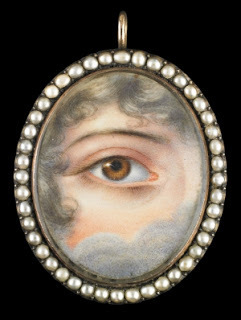 Gold oval pendant surrounded by seed pearls, ca. 1830. Brown right eye with clouds.dimentiuons 1 7/8 (with hanger) x 1 3/8 x 1/4 in.
Gold oval pendant surrounded by seed pearls, ca. 1830. Brown right eye with clouds.dimentiuons 1 7/8 (with hanger) x 1 3/8 x 1/4 in.The Look of Love: Eye Miniatures from the Skier Collection opens on October 7, 2012 at the Georgia Museum of Art at the University of Georgia, Athens. It continues until January 6, 2013, in the Dorothy Alexander Roush and Martha Thompson Dinos Galleries.
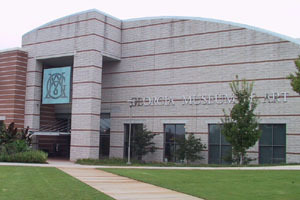 Georgia Museum of Art
Georgia Museum of ArtThis blog has covered the exhibition at its first showing in Birmingham, AL, several times: Here by Victoria, and Here and Here by Guest Blogger Jo Manning. This is the first ever exhibition devoted to these unique miniature representations of lover's eyes, and we hope that a number of our readers can attend this new venue.
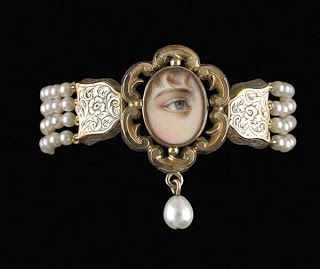 Bracelet surmounted with miniature in gold surround with drop pearl; Gray right eye.1 5/8 x 2 x 1/4 in. (surround only)
Bracelet surmounted with miniature in gold surround with drop pearl; Gray right eye.1 5/8 x 2 x 1/4 in. (surround only)In the words of the Georgia Museum, "Exquisite in craftsmanship, unique in detail, and few in number, lover’s eye miniatures are small-scale portraits of individual eyes set into various forms of jewelry from late-18th- and early-19th-century England. Part of a trend that began with Britain’s Prince of Wales (later George IV), clandestine lovers exchanged these customized tokens depicting one another’s eyes, as such a feature might only be recognized by persons of the most intimate familiarity."
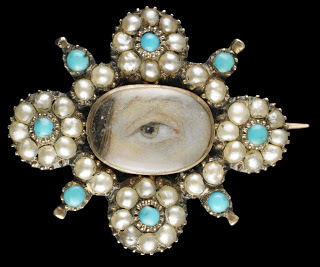 Yellow gold brooch with border of thirty-two natural oriental half-pearls in a floral motif with eight small turquoise stones1 x 1 1/2 x 1/4 in.
Yellow gold brooch with border of thirty-two natural oriental half-pearls in a floral motif with eight small turquoise stones1 x 1 1/2 x 1/4 in.In the exhibition catalogue, Jo Manning has provided five fictional vignettes of possible stories behind Eyes of Love. As the Georgia Museum says, "...behind the skilled artistry with which each of these tiny portraits was painted lie the enchanting stories of secret romance and love lost." Essays by several experts are also included.
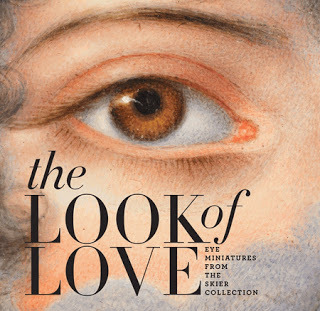
The catalogue is available from the Birmingham Museum of Art, the Georgia Museum of Art and on Amazon.com. Also available is an iPad app created by the Birmingham Museum of Art.About one hundred examples of Eye Miniatures are shown. Many were worn as pins or on rings, necklaces and bracelets. Others are found on patch and toothpick boxes, stickpins and fobs. Many are memorials to lost children or lovers.
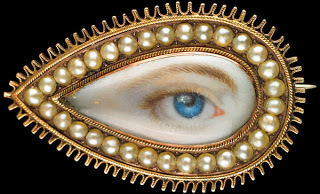 Gold teardrop-shaped brooch surrounded by split pearls, ca 1790. Blue right eye.3/4 x 1 1/4 x 1/4 in.
Gold teardrop-shaped brooch surrounded by split pearls, ca 1790. Blue right eye.3/4 x 1 1/4 x 1/4 in.Whatever their elusive meaning and purpose, you will be fascinated to see this stunning collection.
The Georgia Museum of Art website can be found here.
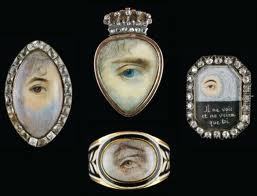
[image error]
Published on October 02, 2012 14:17
Royal London: A Guide
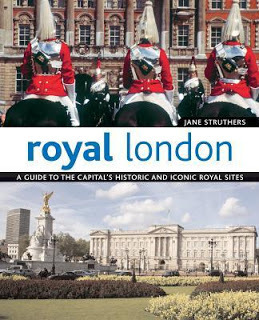
I came across this colorful book, most recently updated and published in 2012, in the library. The full title is Royal London: A Guide to the Capital's Historic and Iconic Royal Sites. More than 100 locations are described from the Buckingham Palace we all know to a Coronation Stone in the Royal Borough of Kingston Upon Thames where seven Saxon Kings were crowned in the 9th and 10th centuries.
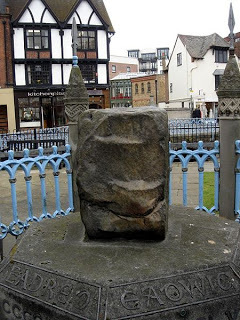 Coronation Stone
Coronation StoneThe author of the volume, Jane Struthers, has written many nonfiction books about England, English History, and other topics.
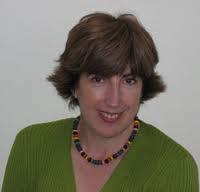 Jane Struthers
Jane StruthersAs readers of this blog might guess, for both Kristine and Victoria, reading about London and looking at pictures are just about our favorite activities in the entire world, short of actually walking in London's streets. So it will come as no surprise to know that Victoria spent quite a few hours with this book. As usual, I (forgive the switch to first person, please) checked out how many of the places I have visited.
The book begins with Westminster, and most of those we have even written about on this blog. Multiple visits to the Palace and to the Queen's Gallery, for example. The processions in the Mall for Trooping the Colour and a walk in the Marlborough House Garden. A walk through Westminster's residential area, just south of Westminster Abbey, including the church St. John's, Smith Square, scene of many excellent musical events.
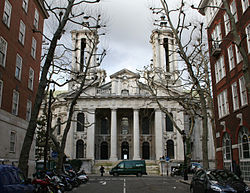 St. John's, Smith Square
St. John's, Smith SquareStruthers relates the story of how the church got the nickname "Queen Anne's Footstool." Supposedly the Queen was annoyed at being asked again what the new building should look like. She kicked over her footstool and said, "Like that!" Therefore the church has four tall towers, only two of which can be seen above. Nevertheless, it is an excellent example of English Baroque and is renowned for its excellent acoustics. It was heavily bombed in WWII and restored as a concert venue.
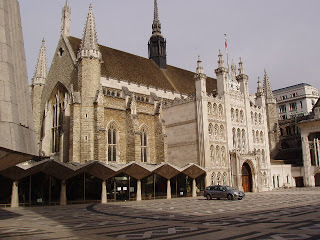 The Guildhall
The GuildhallIn other sections of the City and the metro area, you will find familiar spots described, such as the Guildhall, the Tower of London, and Trafalgar Square. And there are other, lesser known sites with interesting royal connections. Ely Place, for example, is now the site of crown-owned terrace houses, but once Ely House (long gone) was the place Philippa of Hainault stayed at Christmas 1327, before her marriage to Edward III. Who knew?
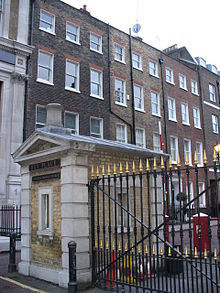 Ely Place
Ely Place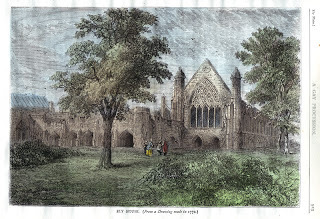 1772 engraving of Ely House and St. Etheldredea's Church
1772 engraving of Ely House and St. Etheldredea's ChurchFamiliar or unusual, it is our beloved London. Now I have a few new targets for my next trip. It can't come soon enough!
[image error]
Published on October 02, 2012 04:46
September 29, 2012
The Naturalist's Diary, October 1826
The Naturalist’s Diary 1826 October
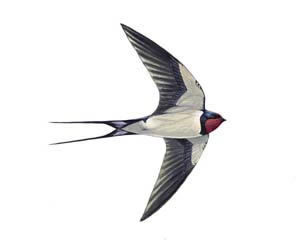 Swallow
Swallow
At the beginning of this month, or latter end of September, some summer birds of passage, of which the swallow is the first, take their departure for warmer regions. The time of their leaving this country varies in different seasons; it is sometimes protracted till the end of October or the beginning of November, and swallows have been seen, in mild weather, to congregate previously to taking their departure, so late as the middle of December. A great diversity of opinion has existed respecting the torpidity and migration of this bird; it is an established fact, that, although the greater part of the swallows that visit England quit the country before the approach of winter, many remain and continue in a state of torpidity till the enlivening sun of April wakes them from their long sleep.
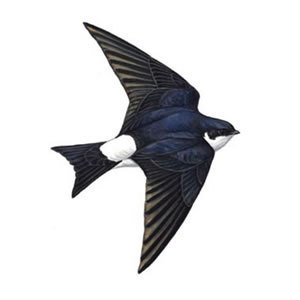 Common House Martin
Common House Martin
The throstle, the red-wing, and the field-fare which migrated in March, now return; and the ring-ouzel arrives from the Welsh and Scottish Alps to winter in more sheltered situations. About the middle of the month, the common martin disappears; and, shortly afterwards, the smallest kind of swallow, the sand-martin, and the stone-curlew, migrate. The Royston or hooded crow (Corvus cornix) arrives from Scotland and the northern parts of England, being driven thence by the severity of the season. The woodcock returns, and is found on our eastern coasts.
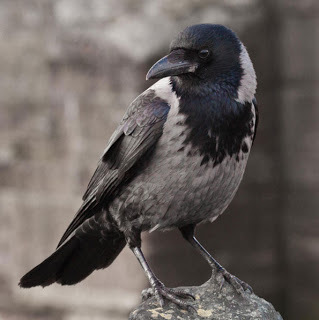 Hooded Crow
Hooded Crow
Small birds now begin to congregate, and the common linnet is the first to lead the way. Various kinds of waterfowl make their appearance; and, about the middle of the month, wild geese quit the fens, and go to the rye and wheat lands to devour the young corn; frequently leaving a field as if it had been fed off by a flock of sheep.
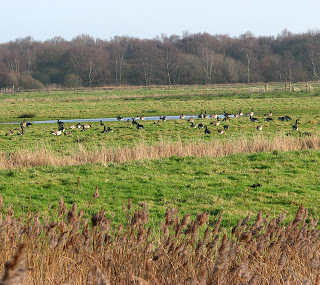 Wild Geese feeding
Wild Geese feeding
Rooks sport and dive, in a playful manner, before they go to roost, congregating in large numbers. The starling sings. The awk or puffin visits for the purpose of incubation, some of the rocky isles of Britain, in amazing numbers.
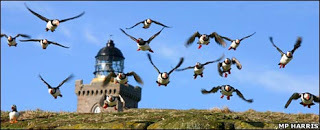 Puffins
Puffins
That singular appearance in nature, the gossamer, occurs in this month. Amid the floral gaieties of autumn, may be reckoned the Guernsey lily, which is so conspicuous an object in October, in the windows and green-houses of florists in London and its vicinity.
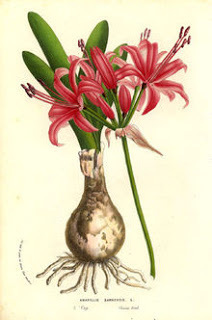 Guernsey Lily
Guernsey Lily
In mild seasons there are many flowers still in blow in this month. Generally speaking, however, the ‘last day of summer’ has passed away.
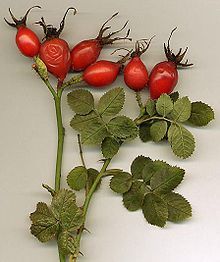 Rose Hips
Rose Hips
Hips and haws now ornament the hedges. The berries of bryony and the privet; the barberry, the blackberry, the holly and the elder, from which an excellent winter wine may be made
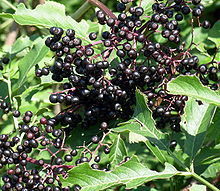 Elderberries
Elderberries
—with sloes, bullaces, and damsons, are now in great plenty.—Blackberries also are ripe in this month, and the collecting of them affords an agreeable pastime to the younger branches of the peasant’s family, as well as some small profit to the parents. These are the fruits of the poor;--they who are more highly favoured with the gifts of fortune revel on the patrician peach and nectarine, the pine and the grape, whose purple clusters contrast so beautifully with the dazzling white of the silver epergne.
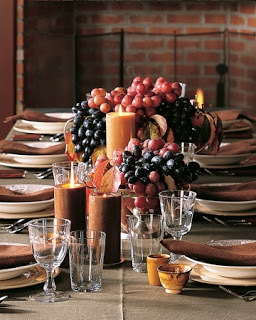 from MarthaStewart.com
from MarthaStewart.com
But these transient pleasures, --the rose-crowned bowl,--the smiles of beauty, the music’s enchanting voice,--soon, too soon, flit away from our grasp and leave us nothing but the memory of a former day, those ‘blossoms of the past.’ During the months of October, November and December, at the fall of the leaf, insects become less numerous, but many of the Hemiptera may be found in the woods, by beating the ferns and underwood, also many very beautiful Tineae and Tortrices; and aquatic insects may be taken in ponds, in great numbers. Roots of grass, decayed trees may again be resorted to.
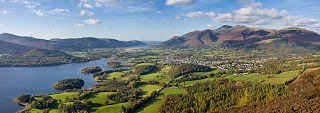 Keswick
Keswick
October, like the proceeding month, is generally spent by the sea-side or in traveling over the varied surface of the United Kingdom. The lakes of Cumberland are an object of high attraction to the lover of the picturesque; the Highlands of Scotland also have a strong claim on his notice, and are frequently visited by our tourists in search of the sublime and romantic scenery of Nature. Scotland, indeed, is eminently entitled to our attention; and whether we take a trip by steam to the ‘modern Athens,’ and return by the land-route through the northern counties of England, or extend our journey and sail on the placid bosom of Loch Katrine, or climb the Alpine heights of Ben Nevis, we shall be amply repaid for the fatigue and expense of the tour.
 Loch Long
Loch Long

 Swallow
SwallowAt the beginning of this month, or latter end of September, some summer birds of passage, of which the swallow is the first, take their departure for warmer regions. The time of their leaving this country varies in different seasons; it is sometimes protracted till the end of October or the beginning of November, and swallows have been seen, in mild weather, to congregate previously to taking their departure, so late as the middle of December. A great diversity of opinion has existed respecting the torpidity and migration of this bird; it is an established fact, that, although the greater part of the swallows that visit England quit the country before the approach of winter, many remain and continue in a state of torpidity till the enlivening sun of April wakes them from their long sleep.
 Common House Martin
Common House MartinThe throstle, the red-wing, and the field-fare which migrated in March, now return; and the ring-ouzel arrives from the Welsh and Scottish Alps to winter in more sheltered situations. About the middle of the month, the common martin disappears; and, shortly afterwards, the smallest kind of swallow, the sand-martin, and the stone-curlew, migrate. The Royston or hooded crow (Corvus cornix) arrives from Scotland and the northern parts of England, being driven thence by the severity of the season. The woodcock returns, and is found on our eastern coasts.
 Hooded Crow
Hooded CrowSmall birds now begin to congregate, and the common linnet is the first to lead the way. Various kinds of waterfowl make their appearance; and, about the middle of the month, wild geese quit the fens, and go to the rye and wheat lands to devour the young corn; frequently leaving a field as if it had been fed off by a flock of sheep.
 Wild Geese feeding
Wild Geese feedingRooks sport and dive, in a playful manner, before they go to roost, congregating in large numbers. The starling sings. The awk or puffin visits for the purpose of incubation, some of the rocky isles of Britain, in amazing numbers.
 Puffins
PuffinsThat singular appearance in nature, the gossamer, occurs in this month. Amid the floral gaieties of autumn, may be reckoned the Guernsey lily, which is so conspicuous an object in October, in the windows and green-houses of florists in London and its vicinity.
 Guernsey Lily
Guernsey LilyIn mild seasons there are many flowers still in blow in this month. Generally speaking, however, the ‘last day of summer’ has passed away.
 Rose Hips
Rose HipsHips and haws now ornament the hedges. The berries of bryony and the privet; the barberry, the blackberry, the holly and the elder, from which an excellent winter wine may be made
 Elderberries
Elderberries—with sloes, bullaces, and damsons, are now in great plenty.—Blackberries also are ripe in this month, and the collecting of them affords an agreeable pastime to the younger branches of the peasant’s family, as well as some small profit to the parents. These are the fruits of the poor;--they who are more highly favoured with the gifts of fortune revel on the patrician peach and nectarine, the pine and the grape, whose purple clusters contrast so beautifully with the dazzling white of the silver epergne.
 from MarthaStewart.com
from MarthaStewart.comBut these transient pleasures, --the rose-crowned bowl,--the smiles of beauty, the music’s enchanting voice,--soon, too soon, flit away from our grasp and leave us nothing but the memory of a former day, those ‘blossoms of the past.’ During the months of October, November and December, at the fall of the leaf, insects become less numerous, but many of the Hemiptera may be found in the woods, by beating the ferns and underwood, also many very beautiful Tineae and Tortrices; and aquatic insects may be taken in ponds, in great numbers. Roots of grass, decayed trees may again be resorted to.
 Keswick
KeswickOctober, like the proceeding month, is generally spent by the sea-side or in traveling over the varied surface of the United Kingdom. The lakes of Cumberland are an object of high attraction to the lover of the picturesque; the Highlands of Scotland also have a strong claim on his notice, and are frequently visited by our tourists in search of the sublime and romantic scenery of Nature. Scotland, indeed, is eminently entitled to our attention; and whether we take a trip by steam to the ‘modern Athens,’ and return by the land-route through the northern counties of England, or extend our journey and sail on the placid bosom of Loch Katrine, or climb the Alpine heights of Ben Nevis, we shall be amply repaid for the fatigue and expense of the tour.
 Loch Long
Loch Long
Published on September 29, 2012 01:00
September 25, 2012
William Morris Gallery Reopens
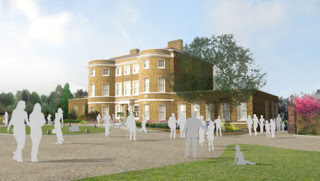
Victoria here, delighted to hear that the William Morris Gallery in Walthamstow, part of northeast London, reopened last month (August, 2012) after a £5m ($8.1m) renovation. I visited the museum a few years ago as an admirer of Morris and his many activities, so an upgrade is welcome news. The website of the museum is here. The museum is operated by the Waltham Forest Council and received assistance from the Heritage Lottery Fund.
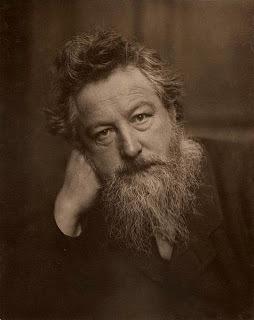 William Morris, age 53, photo by Frederick Hollyer
William Morris, age 53, photo by Frederick HollyerArtist and designer, Visionary and cultural innovator, publisher and writer of prose and poetry, socialist thinker and political theorist, entrepreneur and mentor -- William Morris was one of the leading figures of the late Victorian period. He was an influential member of the Pre-Raphaelite Brotherhood and founded the Arts and Crafts Movement, both with enduring international influence.
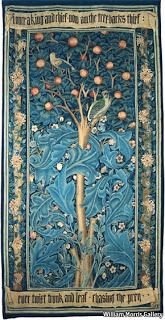 Tapestry: Dreams from Industrial London
Tapestry: Dreams from Industrial LondonThe Economist magazine wrote (More than Just a Pretty Swatch: Homage to a Colourful and Complex Victorian Polymath) recently of the museum's renovation, here. In addition to a collection of more than 10,000 Morris objects, the museum runs education programs, exhibitions of contemporary artists, and many more events, not to mention (naturally) the SHOP and the tea room.
I fell in love with William Morris Designs -- fabric, tapestries, wallpaper, etc. -- long before I even knew his name. His art simply spoke to me on a personal level.
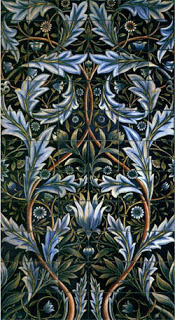 from William Morris Tile
from William Morris TileIf you are a William Morris fan, come along with Kristine and me to Liberty of London on Regent Street ...
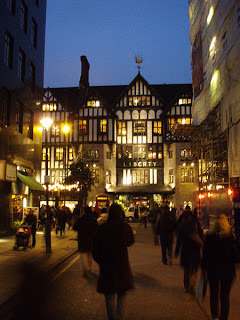 Liberty, Regent Street
Liberty, Regent Street...where we have been known to leave more pounds than we should have! I like it so much I've spent a few hours at home replicating it for my wall -- and Kristine's
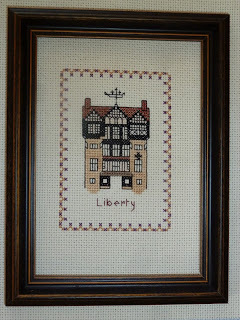 counted cross stitch Liberty
counted cross stitch LibertyA current exhibition at the Tate Britain explores the Pre-Raphaelites: Victorian Avant-Garde through January 13, 2013. The artworks of Dante Gabriel Rossetti, Sir John Everett Millais, William Holman Hunt, Edward Burne-Jones, William Morris and others are included.
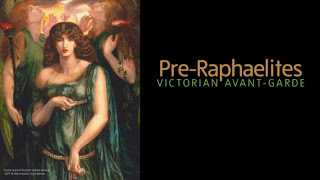
I fear I shall have to miss this excellent show, as I will not be in London before next spring. Boo-hoo. But I have seen many of the pictures and other objects before. The Delaware Art Museum in the U.S. has an excellent collection of Pre-Raphaelites which I have visited. Some are included in the Tate exhibition.
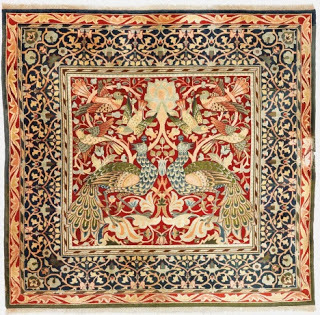 Peacock and Bird Carpet by Morris, Wm. Morris Gallery
Peacock and Bird Carpet by Morris, Wm. Morris GalleryIn addition to the Walthamstow Gallery, in which William Morris lived from age 14 to 22, and the Tate Exhibition, two other National Trust buildings associated with William Morris are open to the public, but be sure to check for limited availabilities.
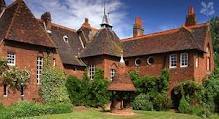 The Red House, NT
The Red House, NTMorris co-designed The Red House in Bexleyheath, southeast London, for his wife, Jane Burden, and family. Once in the country and surrounded by orchards and pastures, it is now in the busy suburbs. Jane and William had two daughters, but lived here only five years, moving due to financial problems. It is being restored to its original condition. Jane often posed for Morris, and his only existing easel painting, below, now in the Tate Gallery, portrays her.
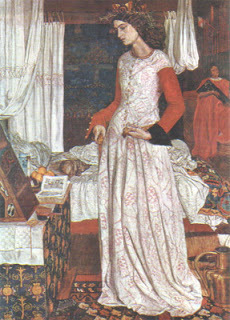 La belle Iseult, 1858
La belle Iseult, 1858Jane also posed for other Pre-Raphaelites, especially for Rossetti, with whom she had a long affair, though she and Morris never divorced.
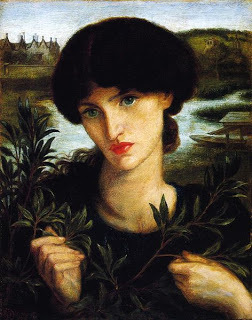 Water Willow, by Rossetti, 1871; Jane Burden Morris, with Kelmscott Manor in the background
Water Willow, by Rossetti, 1871; Jane Burden Morris, with Kelmscott Manor in the backgroundAfter 1971, Morris and his family spent time at their country house, Kelmscott Manor, now open to the public on some days during the summer. It is operated by the Society of Antiquaries of London.
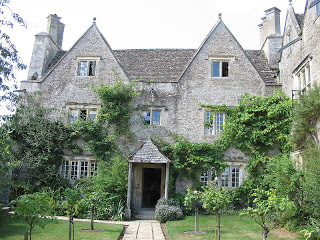 Kelmscott Manor, Oxfordshire
Kelmscott Manor, OxfordshireThe original house dates from 1570 and was both a design project and an inspriation for Morris and his friends. The website is here. The house includes furnishings and textiles designed by Morris, in addition to changing exhibitions and a lovely garden. William Morris is buried in the nearby village churchyard.
Now all I (we) need is unlimited time to wander about England. Let's go.
[image error]
Published on September 25, 2012 13:58
September 23, 2012
Upcoming Masterpiece Theatre
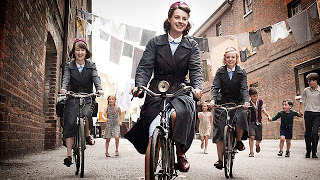
Sunday, September 30, at 8.pm. ET. Call the Midwife is a moving and intimate insight into the colorful world of midwifery and family life in 1950’s East London. We are introduced to the community through the eyes of young nurse Jenny Lee as she arrives at Nonnatus House to live and work as a midwife alongside an Order of Nuns.
As Jenny comes to terms with her new life, we meet some phenomenal people who prove that their warmth, resilience and determination are to be admired beyond measure. At the heart of this world are the Sisters of St. Raymond Nonnatus who have been active in the East End as Anglican nursing nuns since the beginning of the 20th century.
The Sisters and the midwives of Nonnatus House carry out many nursing duties across the community. However, with between 80 and 100 babies being born each month in Poplar alone, their primary work is to help bring safe childbirth to women in the area and to look after their countless newborns.
The drama is based on the best-selling memoirs of the late Jennifer Worth and garnered good reviews, with the Daily Mirror hailing a "new ratings champion at the BBC." A second series already commissioned and talks have now reportedly begun to keep the programme running beyond 2014.
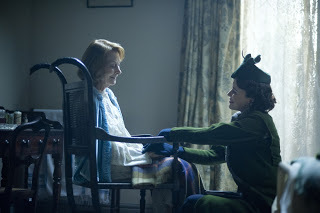
Upstairs, Downstair - Series II - Premieres October 7, 2012 ET on PBS In the year before WWII, 165 Eaton Place reopens its doors and welcomes viewers back into the lives of its inhabitants, upstairs and down. Lady Agnes and Sir Hallam’s family is now complete with the addition of two small children, but Sir Hallam is drawn into dangerous waters by his preoccupation with the threat of Nazi Germany and the return of troubled Lady Persie. Lady Agnes catches the eye of charismatic American multi-millionaire Casper Landry, and Sir Hallam’s aunt, Dr. Blanche Mottershead, has made herself comfortable in the house after Lady Maud’s death. Meanwhile, life downstairs adjusts to the absence of Rose and the addition of the spirited new nursery maid, Beryl. With upstairs and downstairs harboring life-changing secrets, and the menace of war creeping ever closer, the smooth running of Eaton Place threatens to come to a halt.
Gas masks are issued and long-buried secrets about the staff are revealed against an increasingly uneasy political backdrop. While the house staff struggles with the juxtaposition of patriotism and conscience, Sir Hallam stands firm in his diplomatic convictions, helping to negotiate what may be the final chance to avert war. But as the possibility of maintaining peace becomes more apparent, will England be able to sleep quietly for long?
[image error]
Published on September 23, 2012 00:30
Kristine Hughes's Blog
- Kristine Hughes's profile
- 6 followers
Kristine Hughes isn't a Goodreads Author
(yet),
but they
do have a blog,
so here are some recent posts imported from
their feed.



